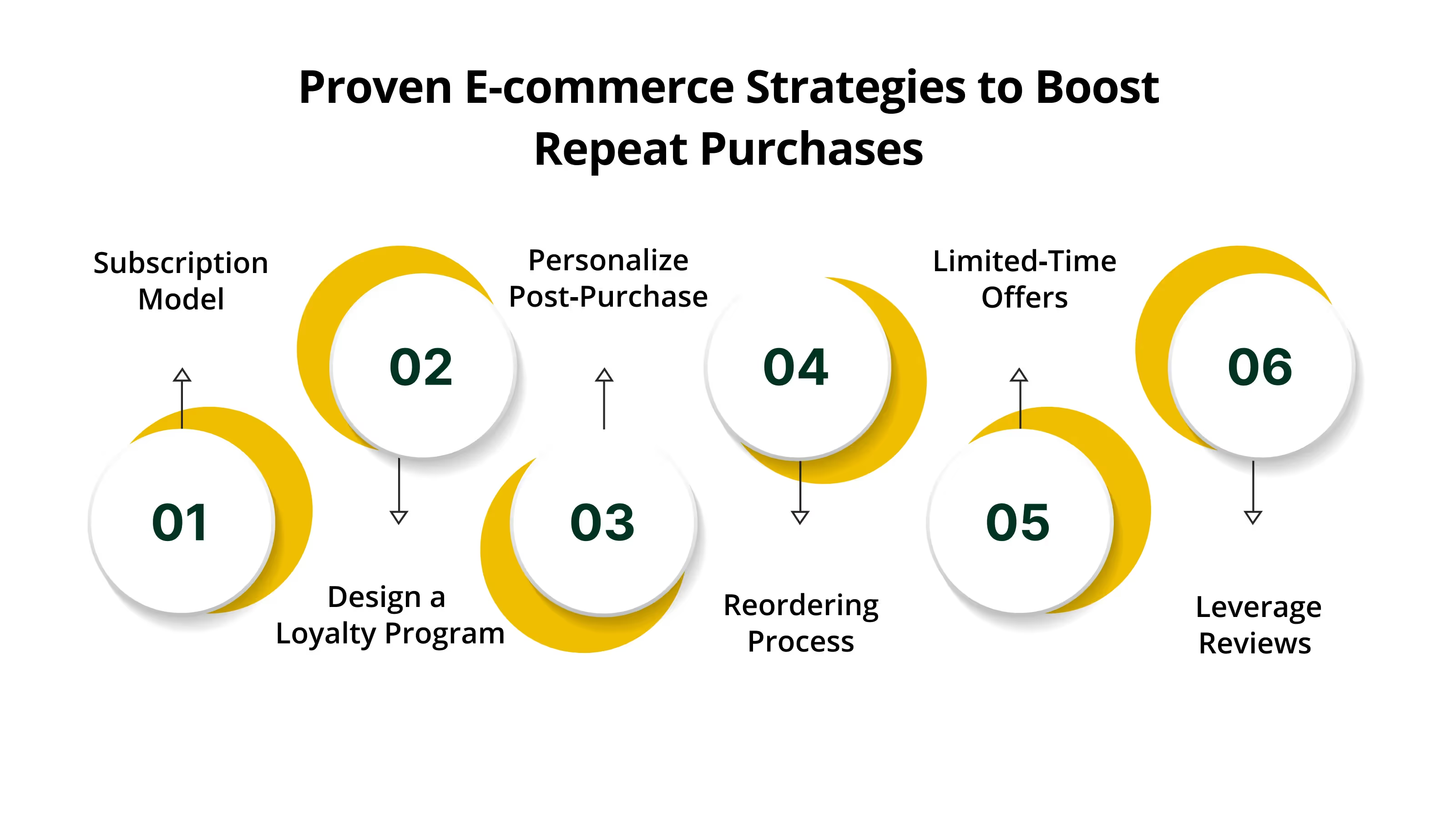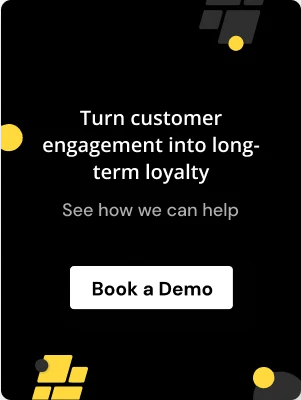.avif)
.avif)
Acquiring new customers can feel like a win, but real growth comes from the ones who already trust your brand. Returning buyers cost less to retain and typically spend more over time, making them a key driver of sustainable revenue. Existing customers spend an average of 67% more than new ones, making them an essential driver of long‑term growth, as per Business.
In this blog, we’ll cover what motivates customers to buy again and share practical strategies from building subscription models to designing loyalty programs that make repeat purchases a natural part of their journey.
Key Takeaways
- E-commerce subscribe repeat purchase strategies help create predictable revenue and long‑term customer loyalty.
- Loyalty programs, subscriptions, and personalized communication keep customers engaged well beyond their first purchase.
- Simplifying reordering reduces friction, making it easier for customers to buy again.
- Tracking metrics like repeat purchase rate, churn, and CLV ensures your strategies stay effective and scalable.
What Drives Repeat Purchases in E-commerce?
A repeat purchase is simply when a customer comes back to buy from you again. But in ecommerce, this behavior reflects much more than convenience; it signals trust, satisfaction, and a growing relationship with your brand. Unlike one‑off transactions, repeat purchases are a key driver of customer lifetime value (CLV), the metric that helps you understand how much revenue a single customer is likely to generate over time.
It’s also important to distinguish between a standard repeat purchase and a subscription purchase. A repeat purchase happens when a customer returns on their own to buy again, while a subscription purchase involves an intentional commitment, for example, signing up for a monthly replenishment of essentials or a curated product box. Subscription models are a powerful tool for retention because they create predictable revenue streams and deepen the customer’s connection to your business.
This is where e-commerce subscribe repeat purchase strategies come into play. By combining the flexibility of repeat purchasing with the consistency of subscriptions, these models help stabilize revenue, reduce churn, and make long‑term growth more achievable.

Proven E-commerce Strategies to Boost Repeat Purchase

A Bain & Company study found that increasing customer retention by just 5% can lift profits by 25% to 95%. In simple terms, customers who return to your brand often tend to become far more valuable over time.
Most e-commerce brands invest heavily in acquiring new customers but fall short when it comes to keeping them engaged long-term. This imbalance is costly. Below are actionable strategies that move beyond one‑time conversions and create systems that make customers return consistently.
1. Building an E-commerce Subscription Model for Repeat Purchase Growth
Subscriptions go beyond convenience; they change how customers engage with your brand. By reducing the need for frequent purchase decisions, you turn one‑time buyers into long‑term customers with predictable buying habits. Here’s how different models work and when to use them:
- Replenishment subscriptions: Best suited for consumables like vitamins, pet food, or cleaning products. They solve a functional problem (never running out of essentials) and naturally drive high retention because customers see immediate, ongoing value.
- Curated boxes: These work for lifestyle brands, offering variety and discovery (e.g., beauty kits, snacks, or apparel). Customers keep coming back not just for the product but for the excitement of “what’s next.”
- Membership programs: Ideal for brands with strong communities or premium offerings. Beyond discounts, they can include early access to launches, exclusive content, or member‑only experiences, strengthening brand affinity.
The takeaway? A well‑designed subscription program doesn’t just increase purchase frequency. It makes reordering effortless, builds trust over time, and integrates your brand into customers’ routines.
2. Design a Loyalty Program Customers Use
Most points‑only programs fail because customers don’t see a meaningful benefit; earning a few points on every purchase often feels slow and uninspiring. To make a loyalty program effective, it needs to create a clear sense of progress and value:
- Tiered benefits that grow with engagement: Unlocking free shipping, exclusive products, or higher-value perks as customers hit spending milestones creates a reason to keep returning.
- Gamification that sustains interest: Progress bars, achievement badges, or limited-time challenges make participation enjoyable and keep customers actively engaging with your program beyond transactions.
- Experiential rewards that foster connection: Early access to new collections, members-only events, or personalized offers add emotional weight to the relationship, turning customers into advocates rather than just repeat buyers.
When combined with a subscription model, loyalty programs become even more powerful. Customers earn rewards simply by staying subscribed, creating a natural loop that keeps them engaged and coming back.
3. Personalize Post‑Purchase Communication
The time immediately after a purchase is a critical window for building loyalty. Customers who feel acknowledged and guided during this phase are far more likely to return. Personalization here is about more than just adding a name to an email; it’s about making every interaction purposeful:
- Thoughtful thank‑you messages: Go beyond generic templates by acknowledging what they purchased and offering tips or content that complements their order. For instance, a skincare brand might share a simple routine featuring their new product.
- Timely reorder nudges: Use purchase data to anticipate when they’ll need a refill or seasonal product restock. A well‑timed reminder can feel helpful, not pushy, especially for essentials or limited‑shelf‑life items.
- Curated product suggestions: Recommend items that complement their past purchases or browsing history, making discovery effortless. Instead of “you might also like,” frame it as solving their next need.
When communication feels relevant and timed to their journey, customers don’t just see your brand as a store; they experience it as a partner anticipating their needs.
4. Simplify the Reordering Process
When reordering feels like a chore, customers are more likely to look elsewhere. Your goal should be to remove friction at every step so coming back feels effortless:
- One‑click reorders for past purchases: Let customers reorder their regular items directly from their account or even receive a reminder email. This works especially well for consumables like supplements or skincare.
- Persistent carts and wishlists: Saving their selections means customers don’t need to search or start over, which makes them far more likely to complete the purchase.
- Flexible auto‑refills: Offer subscription‑style replenishment with options to adjust quantities or skip deliveries. This gives customers control while ensuring they don’t run out of essentials.
- Incentives for quick action: Adding perks like bonus points or small discounts for reordering within a set time frame creates a subtle nudge without feeling pushy.
Streamlining reorders isn’t just about convenience; it’s about removing barriers that make customers second‑guess returning.
5. Use Targeted Promotions & Limited‑Time Offers
Discounts alone rarely build loyalty; they’re most effective when they feel intentional and relevant to each customer’s journey. Instead of blanket markdowns, focus on offers that connect to customer behavior and context:
- Seasonal or lifecycle campaigns: Use purchase history to trigger timely offers, for example, reminding customers to restock skincare products before winter or suggesting complementary items ahead of a holiday. These messages feel like helpful nudges rather than generic sales pitches.
- Referral‑based incentives: Reward both the referrer and the new customer with credits, bonus points, or exclusive perks. This turns loyal buyers into advocates and introduces new customers through a trusted recommendation.
- Purposeful urgency: Limited‑time offers can be effective when tied to meaningful events (e.g., a new product launch or anniversary sale) rather than overused flash discounts, which can dilute brand value.
When promotions are timely, personalized, and beneficial, customers see them as added value, not a push to spend.
6. Use Reviews & Social Proof
For customers deciding whether to buy again, trust plays a bigger role than discounts. Reviews and social proof bridge that gap by validating their past decisions and influencing future ones. But simply collecting reviews isn’t enough; how you use them determines their impact.
- Make reviews part of your loyalty loop: Encourage customers to share their experiences by rewarding them with points or exclusive perks. For example, offering double points for photo or video reviews creates richer, more persuasive content while keeping customers engaged with your loyalty program.
- Integrate user‑generated content across touchpoints: Don’t let reviews sit passively on product pages. Bring them into post‑purchase emails (“Here’s how others are using their product”), social campaigns, and even reorder reminders. Brands have grown by turning customer photos and feedback into powerful storytelling tools.
- Segment and display reviews strategically: Highlight context‑specific feedback to reinforce buying confidence. For instance, showcase durability reviews for frequently reordered products or highlight service‑related testimonials when sending subscription renewal reminders. This ensures customers see the feedback most relevant to their next purchase.
Driving repeat purchases isn’t about offering endless discounts; it’s about creating seamless, rewarding experiences that make customers want to return. Tools like Nector help brands bring subscriptions, loyalty programs, reviews, and referrals together in one platform, making it easier to automate engagement and build lasting customer relationships.
Read: 2025 DTC Trends: How Shopify Brands Can Stay Ahead with Loyalty and Retention
Overcoming Common Barriers to Repeat Purchases

Getting a customer to buy once is easy compared to getting them to return. Repeat purchases don’t just happen because you have a good product; they require ongoing value, consistent engagement, and a friction‑free experience. But many ecommerce brands run into common barriers that quietly undermine their retention efforts. Let’s break down the most common obstacles that prevent customers from coming back and explore practical ways to overcome them:
1. Subscription Fatigue:
Subscriptions are meant to make life easier for customers while giving your business steady revenue. But when they’re too rigid, they can do the opposite, leaving customers feeling trapped, overstocked, or disconnected from your brand. This often happens when customers can’t align delivery schedules with their real needs or feel they’ve lost control over the buying process.
To prevent this:
- Offer true flexibility: Give customers the option to adjust delivery dates, change product quantities, or temporarily pause their subscriptions. When people feel they can control the experience, they’re far more likely to stick with it.
- Proactively communicate: Instead of waiting for cancellations, engage customers ahead of renewals. A simple check-in asking if they want to modify, skip, or swap an item shows you respect their preferences and prevents dissatisfaction from building up.
- Look for early warning signs: Review patterns in cancellations, skipped orders, or reduced engagement. Identifying when and why customers disengage helps you refine your subscription model before small issues lead to churn.
2. Loyalty Programs That Fail to Engage:
A loyalty program should feel like an ongoing relationship, not a distant promise of rewards that may never materialize. Many programs fail because they’re built around slow, generic point systems that don’t create a sense of progress or excitement. When customers can’t see immediate value or feel the rewards are irrelevant to their preferences, engagement drops quickly.
To prevent this:
- Deliver value from the start: Give customers a reason to care immediately, whether it’s a small bonus for joining, an exclusive perk on their next order, or a meaningful reward for their first repeat purchase. This sets the tone that your program benefits them.
- Make progress visible and worthwhile: Tiered programs work because they create milestones to strive for. Unlocking better benefits as customers spend more, like free shipping, early access, or unique offers, keeps them motivated and actively participating.
- Continuously monitor engagement: Don’t just look at enrollment numbers. Track how often customers earn and redeem rewards, and identify where activity drops off. This helps you refine the program so it feels dynamic and keeps your audience invested over time.
3. Fragmented Data That Blocks Insight:
When customer data is scattered across multiple tools, your CRM, email platform, loyalty software, and analytics dashboards, it creates silos that make it impossible to see the full customer journey. This disconnect often leads to poorly timed campaigns, irrelevant offers, and missed opportunities for re‑engagement. Without a unified view, your team is essentially making decisions based on fragments, not the complete story.
To prevent this:
- Consolidate data for a single customer view: Integrating your platforms into a unified system allows you to track behavior across channels, from how often someone engages with emails to when they last redeemed loyalty points or made a purchase. This context helps you spot patterns and design actions that resonate with each customer segment.
- Measure what matters: Focus on core metrics like repeat purchase rate, customer lifetime value, and order frequency. These aren’t just numbers; they reveal how strong your relationships with customers are and whether your retention strategies are making a tangible difference.
- Turn insight into action: Use these consolidated insights to trigger relevant campaigns such as timely reorder prompts, tailored offers, or re‑engagement messages, instead of relying on one‑size‑fits‑all approaches that often miss the mark.
4. Over‑Reliance on Discounts:
Discounts are an easy way to drive sales in the short term, but when they become your primary retention strategy, they can work against you. Customers begin to associate your brand with price cuts rather than value, leading them to delay purchases until the next sale. Over time, this erodes your margins and makes it harder to build loyalty based on anything other than cost.
To prevent this:
- Shift focus from discounts to value‑driven incentives: Instead of relying on price reductions, give customers reasons to stay engaged, such as loyalty rewards they can accumulate over time, exclusive access to new collections, or perks reserved for members. These create a sense of belonging and value without cutting into profits.
- Understand promotion dependency: Analyze how many repeat purchases occur without a discount versus those triggered by promotional offers. This distinction helps you see whether customers are buying because of a genuine connection to your brand or simply chasing deals.
- Create layered engagement: Combine small, meaningful rewards (like bonus points for early reorders) with experiential perks (early access or members‑only offers). This approach reinforces loyalty without making price the only reason to return.
Retention takes ongoing effort, and without the right data, it’s easy to miss what needs fixing. Tracking repeat purchases, churn, and loyalty engagement gives you a clearer picture of customer behavior and where to improve. Platforms like Nector bring subscription, loyalty, and referral data into one platform, making it easier for your team to refine strategies and build lasting customer relationships.

Read: A Complete Guide to Customer Advocacy: Drive Loyalty and Brand Success
Wrapping Up
Retention is about giving customers reasons to return through experiences that feel valuable and effortless. This requires understanding their behavior, addressing where engagement drops, and aligning strategies that work together. Platforms like Nector bring loyalty, subscription, and referral data into one view, helping teams make informed decisions and strengthen long‑term customer relationships.
If you’re ready to turn retention into a reliable growth engine without overcomplicating your workflows, Book A Demo with Nector and see how it can help your team create meaningful, repeat‑driven customer experiences.
FAQs
1. What is an ecommerce subscribe-repeat purchase model, and why does it matter?
It’s a model that combines recurring deliveries with the flexibility of traditional shopping. Instead of relying on customers to remember to reorder, it creates predictable buying habits that strengthen loyalty and generate consistent revenue for your business.
2. How can I design a loyalty program that feels meaningful to customers?
Focus on offering more than just points. Tiered rewards, immediate perks for joining, and personalized offers give customers a clear sense of progress and value, encouraging them to return and stay connected with your brand over time.
3. What’s the most effective way to make reordering effortless?
Remove friction from the process by offering one‑click reorders, auto‑refills, and pre‑filled carts. Features like these save customers time and make returning to your store feel effortless, which increases the likelihood of repeat purchases.
4. Why should I be cautious about using discounts as a retention strategy?
Overusing discounts can erode your brand’s value and train customers to wait for sales. Instead, balance occasional offers with loyalty rewards, early access to new products, or members‑only perks to create lasting engagement without cutting into profits.
5. What metrics should I track to measure repeat purchase success?
Start with key metrics like repeat purchase rate, customer lifetime value (CLV), and churn for subscription models. These insights help you evaluate retention strategies, identify gaps, and refine your approach for long‑term growth.
FAQs
Start Building Customer Retention That Lasts






.avif)

.avif)

